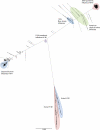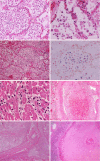Two years after pandemic influenza A/2009/H1N1: what have we learned?
- PMID: 22491771
- PMCID: PMC3346300
- DOI: 10.1128/CMR.05012-11
Two years after pandemic influenza A/2009/H1N1: what have we learned?
Abstract
The world had been anticipating another influenza pandemic since the last one in 1968. The pandemic influenza A H1N1 2009 virus (A/2009/H1N1) finally arrived, causing the first pandemic influenza of the new millennium, which has affected over 214 countries and caused over 18,449 deaths. Because of the persistent threat from the A/H5N1 virus since 1997 and the outbreak of the severe acute respiratory syndrome (SARS) coronavirus in 2003, medical and scientific communities have been more prepared in mindset and infrastructure. This preparedness has allowed for rapid and effective research on the epidemiological, clinical, pathological, immunological, virological, and other basic scientific aspects of the disease, with impacts on its control. A PubMed search using the keywords "pandemic influenza virus H1N1 2009" yielded over 2,500 publications, which markedly exceeded the number published on previous pandemics. Only representative works with relevance to clinical microbiology and infectious diseases are reviewed in this article. A significant increase in the understanding of this virus and the disease within such a short amount of time has allowed for the timely development of diagnostic tests, treatments, and preventive measures. These findings could prove useful for future randomized controlled clinical trials and the epidemiological control of future pandemics.
Figures









Similar articles
-
Estimated global mortality associated with the first 12 months of 2009 pandemic influenza A H1N1 virus circulation: a modelling study.Lancet Infect Dis. 2012 Sep;12(9):687-95. doi: 10.1016/S1473-3099(12)70121-4. Epub 2012 Jun 26. Lancet Infect Dis. 2012. PMID: 22738893
-
An influenza A H1N1 virus revival - pandemic H1N1/09 virus.Infection. 2009 Oct;37(5):381-9. doi: 10.1007/s15010-009-9181-5. Epub 2009 Sep 18. Infection. 2009. PMID: 19768379 Review.
-
[Trends in and challenges for highly pathogenic avian influenza A (H5N1)].Nihon Rinsho. 2010 Sep;68(9):1736-42. Nihon Rinsho. 2010. PMID: 20845757 Japanese.
-
[Pandemic influenza A/H1N1 (sw2009) in Russia: epidemiology, diagnosis, clinical picture, and treatment].Ter Arkh. 2010;82(11):10-4. Ter Arkh. 2010. PMID: 21381341 Russian.
-
H1N1 influenza: critical care aspects.Semin Respir Crit Care Med. 2011 Aug;32(4):400-8. doi: 10.1055/s-0031-1283280. Epub 2011 Aug 19. Semin Respir Crit Care Med. 2011. PMID: 21858745 Review.
Cited by
-
Whole-genome analysis of circulating influenza A virus (H3N2) strains in Shanghai, China from 2005 to 2023.Emerg Microbes Infect. 2024 Dec;13(1):2396867. doi: 10.1080/22221751.2024.2396867. Epub 2024 Sep 5. Emerg Microbes Infect. 2024. PMID: 39193626 Free PMC article.
-
Emerging Pulmonary Infections in Clinical Practice.Adv Clin Radiol. 2021 Sep;3:103-124. doi: 10.1016/j.yacr.2021.04.010. Epub 2021 Jun 2. Adv Clin Radiol. 2021. PMID: 38620910 Free PMC article. Review. No abstract available.
-
Sensitivity and specificity of in vitro diagnostic device used for influenza rapid test in Taiwan.J Food Drug Anal. 2013 Oct 6;22(2):279-284. doi: 10.1016/j.jfda.2013.09.011. eCollection 2014. J Food Drug Anal. 2013. PMID: 38620156 Free PMC article.
-
Current Uses and Future Perspectives of Genomic Technologies in Clinical Microbiology.Antibiotics (Basel). 2023 Oct 30;12(11):1580. doi: 10.3390/antibiotics12111580. Antibiotics (Basel). 2023. PMID: 37998782 Free PMC article. Review.
-
Preparation for the next pandemic: challenges in strengthening surveillance.Emerg Microbes Infect. 2023 Dec;12(2):2240441. doi: 10.1080/22221751.2023.2240441. Emerg Microbes Infect. 2023. PMID: 37474466 Free PMC article.
References
-
- Agrati C, et al. 2010. Association of profoundly impaired immune competence in H1N1v-infected patients with a severe or fatal clinical course. J. Infect. Dis. 202: 681–689 - PubMed
-
- Alexander DJ. 2007. An overview of the epidemiology of avian influenza. Vaccine 25: 5637–5644 - PubMed
-
- Alfaresi M, Albedwawi S, Hag-Ali M. 2011. Detection of an oseltamivir-resistant pandemic influenza A/H1N1 virus in the United Arab Emirates. Med. Princ. Pract. 20: 97–99 - PubMed
Publication types
MeSH terms
Substances
LinkOut - more resources
Full Text Sources
Other Literature Sources
Medical
Miscellaneous

